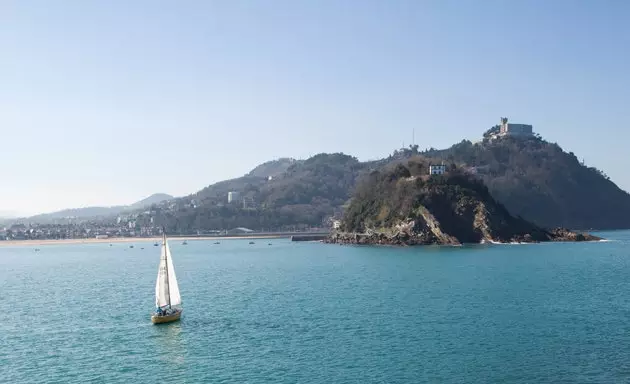
The bay of San Sebastian has an enviable beauty
Winnie lives in New York and works for a prestigious food magazine in Los Angeles. We met a couple of years ago and one night on the Lower East Side she promised that she would come to visit me . Now, on her ‘Grand Tour’ she makes a stop in ** San Sebastián **. To see me. To write the reports of it. “Half work, three quarters leisure”, as she says when asked about her life.
We stayed at the Hotel Londres y de Inglaterra as if we were two ladies from the Belle Époque who came to take baths in the waves. Our room is classic: carpet, damask bedspreads, and gilt-framed pictures of English landscapes; and we also have the best views of the bay.
When night begins to fall, the little lights of the Urgull and Igueldo mountains and those of the island of Santa Clara light up little by little and are reflected in the sea. She is surprised that everything is so perfect . That nothing is missing. That not about anything. Me too . And it is not very common (not to say a miracle), that at this point in Spain there is a coastline as uniform as this one. Of course, this translates into the prices that her neighbors pay for never losing sight of her: one of the most inaccessible square meters of the bull skin.
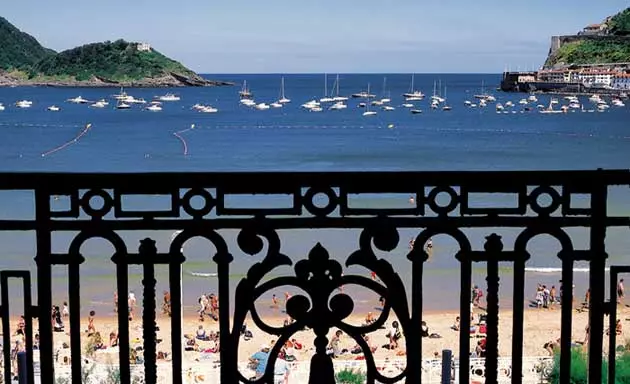
Views of La Concha Beach from one of the rooms at the Hotel Londres, one of Álvaro's favourites.
We strolled to Pescadería street with the aim of (re)trying Néstor's potato omelettes. The place does not have too much mystery, a typical and small inn, but his tortillas have the perfect point Pairing: very poached potato and onion and slightly curdled egg, the kind that spills onto the plate. The only 'but' that can be put is that they are only prepared twice a day: at 1:00 p.m. and at 8:00 p.m.
Then, there is always the option of approaching Íñigo street and launching, without hesitation, into the meat . But not just any one, but the tender and juicy tenderloin from Astelena, this one is already a much more modern and minimalist place.
It is more difficult for us to decide endless Ormazabal bar (Calle del Treinta y Uno de Agosto, 22) where, as in many of the bars in the old part, the custom has been adopted (especially if they see you with a foreign face) of giving a plate to the customer to fill it in one go, something that the people of Donostia still don't like, accustomed to eating depending on what they feel like.
Winnie is led blindly and no suggestion is unwelcome. She always travels with two notebooks. One in which she writes what happens to her every day and another in which she pastes the cards of the bars and restaurants that she visits. She always carries it with her and before the little cards get misplaced she takes out a roll of tape and carefully sticks it down, making a hole. Note: “you I have best tortilla ever !!!!”.
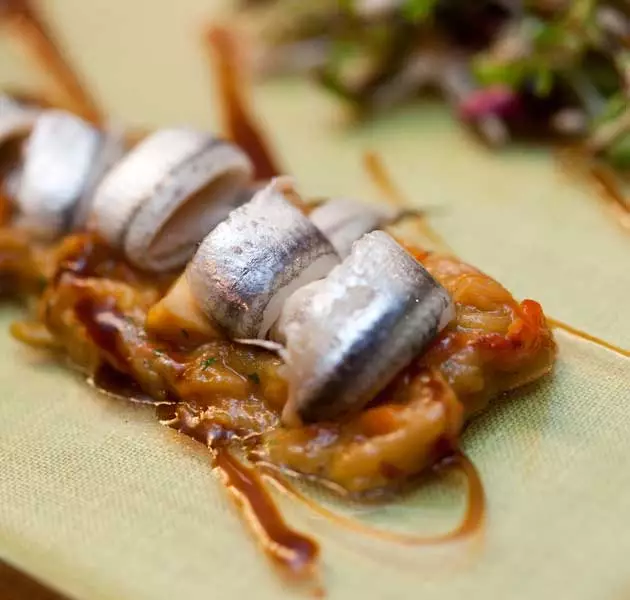
Marinated anchovies on roasted vegetables are an institution at the Urepel restaurant
La Cuchara de San Telmo (Treinta y Uno de Agosto, 28) is definitely one of my favorite places. Although their service is not the friendliest in town and sometimes it is so crowded that you have to stand at the door with the small plates . It was one of the first bars in San Sebastián to establish the custom of serving hot pintxos on request. Here there is no doubt about what to order: the best is the fresh foie, which is accompanied by a teaspoon of apple, and the risotto, even richer than the Italian, because instead of Parmesan it has Idiazábal cheese, a mature pecorino cheese that goes well with almost everything.
A Fuego Negro (Treinta y Uno de Agosto, 31) raises conflicting opinions, but the truth is that the place has something that most of the bars in the old part lack: the atmosphere is younger and livelier, the music is good and the creations are the most original , like the pickled ear accompanied with mole ice cream or the spider crab with avocado and liquorice. That's why modern thirtysomethings know their letter by heart.
On the blackboard that covers the bar, you are tempted by the suggestions of the house, pintxos, salads, txupitos and 'kositas' that are served both on a plate and in a glass and that change with the season . One of his greatest successes was his sweet pintxos. My favorites: the truffles and rice pudding, creamy, creamy. To snack, Winnie asks for some huge olives, even though I tell her they're not from the land. “Trust me!” she scolds me. And she is right. Her difference is her filling: a splash of vermouth. The result is unexpected. Even for someone from Jaén like me.
Now, in return, I make my friend from New York judge the kobe hamburger (the MacKobe), accompanied by plantain chips. I think she likes it because she eats it in two bites. Fascinated, she asks the bartender where she can buy the ketchup. To her disappointment, it's a homemade recipe. Maybe she'll consider importing it.
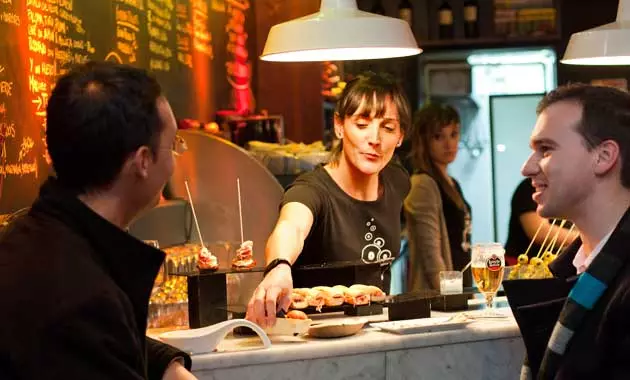
Pintxo bars reinvent themselves. A good example of this is the controversial A Fuego Negro
Today is Saturday and, contrary to what Winnie expected, San Sebastián is not a city with a memorable nightlife . At some point it was, but now in this, too, it is Frenchified, with early hours and quiet evenings. Failing that offers mountain and bike mornings and even, for the pros from Donostia, a swim in the sea . Whatever the season. And no matter how old they are.
For those from outside, **early Saturdays are also a good time to visit La Bretxa market**. For many years, the landladies have been selling in the same place, despite the fact that the beautiful traditional food market –like what happened with San Martín, also highly recommended– was transformed into a dull and clonic space with chain stores and restaurants.
In its butchers and fishmongers, the chefs of the best restaurants in the city buy in person . They look at the sparkle in the eyes of the fish to see if they are fresh, they compare the pieces of meat before deciding, and they chat with the landladies, who sell vegetables and farm products. They always specify their DNA on the labels: "belly tuna from here", "ox from the land", "euskolabel" products...
Knowing who to contact almost black market you can buy eggs in recycled boxes and freshly milked milk in Coca Cola bottles . No treatments, no barcode, no expiration date. More 'echo', impossible . Another option, more orthodox, is to take a glass container to the vending machines that have been installed in some parts of the city (such as in Plaza Easo) to buy milk of the day.
Winnie wants to buy some groceries to take home, so we walk best delicatessens : Don Serapio (Sancho the Wise, 22) ; Lukas Gourmet (Paseo de la Zurriola, 1) and Solbes (Aldamar, 4). In all of them they offer autochthonous seasonal products and vacuum-packed. La Olivia (Igentea, 2) sells a selection of oils, olives and soaps and, next door, Oiartzun (Igentea, 2) the best nougats. Amused, Winnie gets hold of a wine from the year of her birth at the Bergara liquor store.
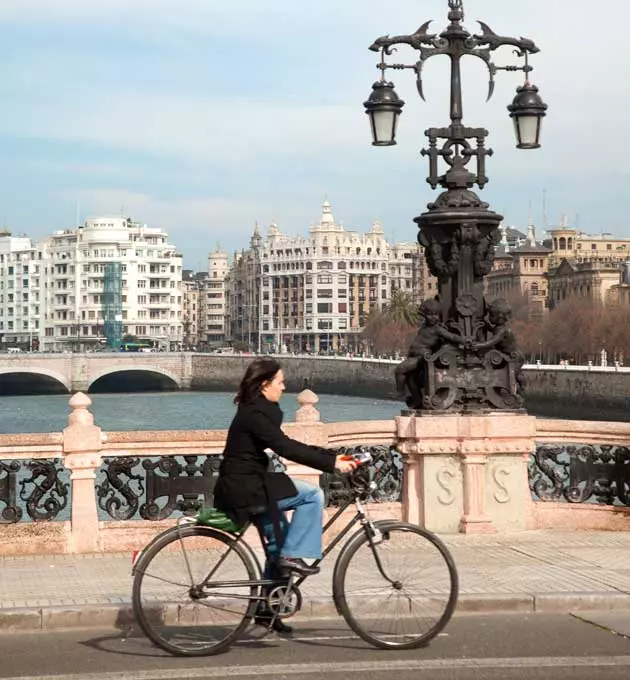
The quiet nights of San Sebastian are offset by mornings on a bike
Although the tradition of pintxos is not as deeply rooted in the center as in the old part, here there are also several places that should not be left out of the route . After all, it's time for lunch. The Hika Mika (Etxaide, 4) is unique for its beef cheek, the Iturrioz (Aldamar, 12) because it makes pintxos as original as the bundle of squid with an oven-pickled txitxarro, and Casa Vallés (Reyes Católicos, 10), an essential where you have to try the mythical Gilda (anchovy, four chillies and an olive), “spicy and intense” as Rita Hayworth.
Something that draws attention to those who come from outside is the number of windows of luxury firms that are seen in the city, how well cared for all the showcases are , even those of the smallest and most insignificant businesses, and the taste of people to dress up. The core is around the Avenida de la Libertad and its intersections, with large international chains, such as Mango or Zara, haute couture firms such as Loewe, and local flagships such as Auzmendi.
The Cortés tailor shop (Hernani, 13) is a classic that has been making tailored suits, tuxedos and shirts for the most elegant gentlemen since 1954. With a more modern and surfer genre, on the same street are the Loreak Mendian and Cabo Rojo boutiques , and on Calle Loyola shops like Arbelaitz , which sells clothes from big brands, or Gerónimo, a specialist in sneakers and trainers. In Berriz, on Hondarribia street, you can find brands such as A.P.C., Alexander McQueen, Vanessa Bruno, La Vie de Rosita, Acne, Zadig & Voltaire...
The concept store 90 Grados (Mayor, 3) is the closest thing to the Parisian Colette in San Sebastián. The local hairdresser Marcial Muñoz has been in full swing for more than twenty years and has assiduous clients such as the millionaire New Yorker Daphne Guinness . It houses a beauty salon, art toys, jewelry, makeup, accessories, and imported books and magazines, with glasses from Cutler & Gross or Harry Larry's. The lower floor is entirely dedicated to signature clothing (Balenciaga, Marc Jacobs, Mad et Len), and footwear, with some limited editions by Hunter.
Luckily we have reserved a thalassotherapy session at La Perla –the best: the jacuzzi overlooking the bay – to recover from the hard work of going through all the windows of the city. Later, a table at Urepel. A knife and fork dinner awaits us. Winnie she highlights the absence of sauces and condiments, the quality of the vegetables and the impossibility of resisting their desserts.
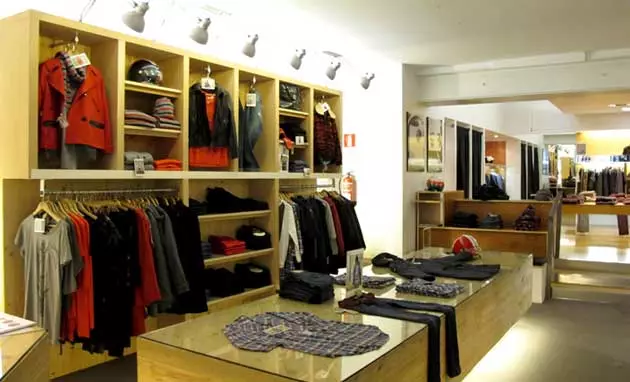
The Loreak Mendian brand, of Basque origin, reflects San Sebastian's concern for caring for the image
It is a bright Sunday morning. The perfect day to take the bus to Pasajes San Pedro (specifically in Oquendo street) and, from its pier, take a little boat to Pasajes San Juan (Pasai Donibane, in Basque) to then return to San Sebastián on foot. Pasajes San Pedro is a port and without charm, but the view of Pasajes San Juan from the motorboat in the estuary is well worth this toll: a seaside town with the flavor of just one street . Therein lies its charm. "Once this was like Venice and everyone had to move in boats, whales were fished and Victor Hugo also visited it", they told me as a child and now I tell it to Winnie.
You can return to Donostia by bus, but it is best to take the Camino de Santiago from the coast and do it on foot . It is only six kilometers along a signposted path with hardly any incline that accompanies hypnotic views of the sea and that leads directly to Mount Ulía, confronted in the distance with Urgull. At the foot of the latter are the Aquarium and the Bokado restaurant, located under the porches of the pier and with views of La Concha beach, less rough and hectic than Zurriola beach. Zurriola is tailored to surfers by being less aristocratic and perfect. Thanks to them the neighborhoods of Gros and Sagüés have been filled with life , in the form of sportswear shops and board and bike rental shops, cafeterias and beach bars.
The Paseo de la Zurriola ends where the Kursaal bridge begins, next to the Kurssal Palace, home of the Film Festival. It also houses several exhibition halls and the Ni Neu restaurant. Its main contribution has been to democratize haute cuisine, or what is the same, to pay 18 euros for a lunch menu of excellent raw materials and impeccable preparation. On days of good weather, like this one, the coffee (and the cup), you have to take them on their terrace, with views of the cubes and the Victoria Eugenia until sunset . If necessary, wrapped up in a blanket to throw the curtain on a weekend in San Sebastian and say goodbye to a friend from New York.
This report was published in issue 49 of the magazine Conde Nast Traveler.
